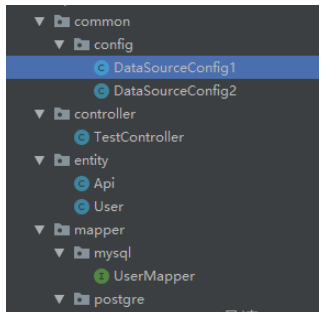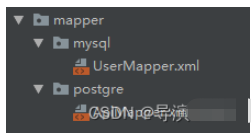您好,登錄后才能下訂單哦!
您好,登錄后才能下訂單哦!
這篇“SpringBoot怎么使用druid配置多數據源”文章的知識點大部分人都不太理解,所以小編給大家總結了以下內容,內容詳細,步驟清晰,具有一定的借鑒價值,希望大家閱讀完這篇文章能有所收獲,下面我們一起來看看這篇“SpringBoot怎么使用druid配置多數據源”文章吧。
使用spring boot配置多數據源,數據源分別為postgresql、mysql
spring boot——2.5.4
druid——1.2.11
postgresql——12
mysql——8.0.16
maven——3.0
idea——2019
java package目錄

resource目錄存放mapper.xml文件,按照數據源創建package

<dependency> <groupId>org.springframework.boot</groupId> <artifactId>spring-boot-starter-data-jpa</artifactId> </dependency> <dependency> <groupId>org.springframework.boot</groupId> <artifactId>spring-boot-starter-test</artifactId> <scope>test</scope> </dependency> <dependency> <groupId>org.springframework.boot</groupId> <artifactId>spring-boot-starter-web</artifactId> </dependency> <!-- https://mvnrepository.com/artifact/com.alibaba/fastjson --> <dependency> <groupId>com.alibaba</groupId> <artifactId>fastjson</artifactId> <version>2.0.4</version> </dependency> <!-- https://mvnrepository.com/artifact/com.alibaba/druid-spring-boot-starter --> <dependency> <groupId>com.alibaba</groupId> <artifactId>druid-spring-boot-starter</artifactId> <version>1.2.11</version> </dependency> <dependency> <groupId>org.mybatis.spring.boot</groupId> <artifactId>mybatis-spring-boot-starter</artifactId> <version>1.3.2</version> </dependency> <dependency> <groupId>org.postgresql</groupId> <artifactId>postgresql</artifactId> <scope>runtime</scope> </dependency> <!-- MySql驅動 --> <dependency> <groupId>mysql</groupId> <artifactId>mysql-connector-java</artifactId> </dependency>
server: port: 8081 spring: datasource: type: com.alibaba.druid.pool.DruidDataSource druid: web-stat-filter: enabled: true #是否啟用StatFilter默認值true url-pattern: /* exclusions: /druid/*,*.js,*.gif,*.jpg,*.bmp,*.png,*.css,*.ico session-stat-enable: true session-stat-max-count: 10 stat-view-servlet: enabled: true #是否啟用StatViewServlet默認值true url-pattern: /druid/* reset-enable: true login-username: admin login-password: admin allow: db1: username: postgres password: localhost url: jdbc:postgresql://localhost:5432/test driver-class-name: org.postgresql.Driver initial-size: 5 # 初始化大小 min-idle: 5 # 最小 max-active: 100 # 最大 max-wait: 60000 # 配置獲取連接等待超時的時間 validation-query: select version() time-between-eviction-runs-millis: 60000 # 配置間隔多久才進行一次檢測,檢測需要關閉的空閑連接,單位是毫秒 min-evictable-idle-time-millis: 300000 # 指定一個空閑連接最少空閑多久后可被清除,單位是毫秒 filters: config,wall,stat # 配置監控統計攔截的filters,去掉后監控界面sql無法統計,'wall'用于防火墻 # 通過connectProperties屬性來打開mergeSql功能;慢SQL記錄 connectionProperties: druid.stat.slowSqlMillis=200;druid.stat.logSlowSql=true;config.decrypt=false test-while-idle: true test-on-borrow: true test-on-return: false # 是否緩存preparedStatement,也就是PSCache 官方建議MySQL下建議關閉 個人建議如果想用SQL防火墻 建議打開 pool-prepared-statements: true max-pool-prepared-statement-per-connection-size: 20 db2: username: root password: localhost url: jdbc:mysql://localhost:3306/springboot?characterEncoding=utf8&useUnicode=true&useSSL=false&serverTimezone=Asia/Shanghai driver-class-name: com.mysql.cj.jdbc.Driver initial-size: 5 # 初始化大小 min-idle: 5 # 最小 max-active: 100 # 最大 max-wait: 60000 # 配置獲取連接等待超時的時間 validation-query: select 'x' time-between-eviction-runs-millis: 60000 # 配置間隔多久才進行一次檢測,檢測需要關閉的空閑連接,單位是毫秒 min-evictable-idle-time-millis: 300000 # 指定一個空閑連接最少空閑多久后可被清除,單位是毫秒 filters: config,wall,stat # 配置監控統計攔截的filters,去掉后監控界面sql無法統計,'wall'用于防火墻 # 通過connectProperties屬性來打開mergeSql功能;慢SQL記錄 connectionProperties: druid.stat.slowSqlMillis=200;druid.stat.logSlowSql=true;config.decrypt=false test-while-idle: true test-on-borrow: true test-on-return: false # 是否緩存preparedStatement,也就是PSCache 官方建議MySQL下建議關閉 個人建議如果想用SQL防火墻 建議打開 pool-prepared-statements: true max-pool-prepared-statement-per-connection-size: 20 mybatis: mapper-locations: classpath:com/demo/mapper/*.xml type-aliases-package: com.demo.entity configuration: log-impl: mapUnderscoreToCamelCase: true #showSql logging: level: java.sql: debug org.apache.ibatis: debug com.demo.mapper: debug config: classpath:logback-spring.xml
@Configuration
@MapperScan(basePackages = "com.demo.mapper.postgre.**", sqlSessionFactoryRef = "oneSqlSessionFactory")
public class DataSourceConfig1 {
// 將這個對象放入Spring容器中
@Bean(name = "oneDataSource")
// 表示這個數據源是默認數據源
@Primary
// 讀取application.properties中的配置參數映射成為一個對象
// prefix表示參數的前綴
@ConfigurationProperties(prefix = "spring.datasource.druid.db1")
public DataSource getDateSource1() {
return DataSourceBuilder.create().type(DruidDataSource.class).build();
}
@Bean(name = "oneSqlSessionFactory")
// 表示這個數據源是默認數據源
@Primary
// @Qualifier表示查找Spring容器中名字為oneDataSource的對象
public SqlSessionFactory oneSqlSessionFactory(@Qualifier("oneDataSource") DataSource datasource)
throws Exception {
SqlSessionFactoryBean bean = new SqlSessionFactoryBean();
bean.setDataSource(datasource);
bean.setMapperLocations(
// 設置mybatis的xml所在位置
new PathMatchingResourcePatternResolver().getResources("classpath*:com.demo.mapper.postgre/*.xml"));
return bean.getObject();
}
@Bean("oneSqlSessionTemplate")
// 表示這個數據源是默認數據源
@Primary
public SqlSessionTemplate oneSqlSessionTemplate(
@Qualifier("oneSqlSessionFactory") SqlSessionFactory sessionFactory) {
return new SqlSessionTemplate(sessionFactory);
}
}@Configuration
@MapperScan(basePackages = "com.demo.mapper.mysql", sqlSessionFactoryRef = "twoSqlSessionFactory")
public class DataSourceConfig2 {
// 將這個對象放入Spring容器中
@Bean(name = "twoDataSource")
// 讀取application.properties中的配置參數映射成為一個對象
// prefix表示參數的前綴
@ConfigurationProperties(prefix = "spring.datasource.druid.db2")
public DataSource getDateSource1() {
return DataSourceBuilder.create().type(DruidDataSource.class).build();
}
@Bean(name = "twoSqlSessionFactory")
// 表示這個數據源是默認數據源
//@Primary
// @Qualifier表示查找Spring容器中名字為oneDataSource的對象
public SqlSessionFactory oneSqlSessionFactory(@Qualifier("twoDataSource") DataSource datasource)
throws Exception {
SqlSessionFactoryBean bean = new SqlSessionFactoryBean();
bean.setDataSource(datasource);
bean.setMapperLocations(
// 設置mybatis的xml所在位置
new PathMatchingResourcePatternResolver().getResources("classpath*:com.demo.mapper.mysql/*.xml"));
return bean.getObject();
}
@Bean("twoSqlSessionTemplate")
// 表示這個數據源是默認數據源
//@Primary
public SqlSessionTemplate oneSqlSessionTemplate(
@Qualifier("twoSqlSessionFactory") SqlSessionFactory sessionFactory) {
return new SqlSessionTemplate(sessionFactory);
}
}關鍵點:去除 exclude = {DataSourceAutoConfiguration.class} 及掃描 com.demo.mapper目錄
@MapperScan("com.demo.mapper")
@SpringBootApplication(exclude = {DataSourceAutoConfiguration.class})
public class DemoApplication {
public static void main(String[] args) {
SpringApplication.run(DemoApplication .class, args);
}
}輸入地址 localhost://8081/druid,輸入 admin/admin
以上就是關于“SpringBoot怎么使用druid配置多數據源”這篇文章的內容,相信大家都有了一定的了解,希望小編分享的內容對大家有幫助,若想了解更多相關的知識內容,請關注億速云行業資訊頻道。
免責聲明:本站發布的內容(圖片、視頻和文字)以原創、轉載和分享為主,文章觀點不代表本網站立場,如果涉及侵權請聯系站長郵箱:is@yisu.com進行舉報,并提供相關證據,一經查實,將立刻刪除涉嫌侵權內容。